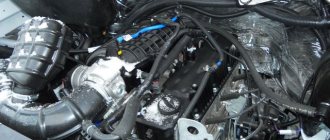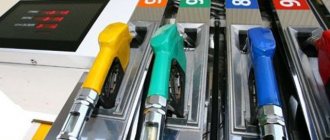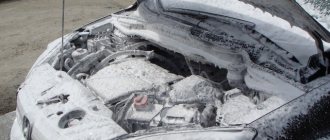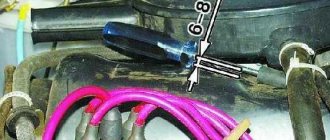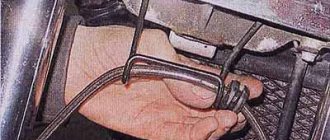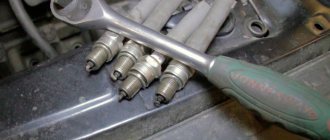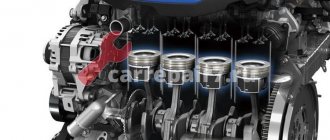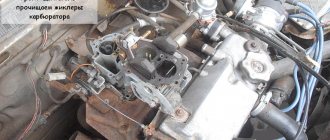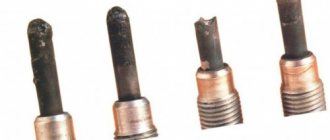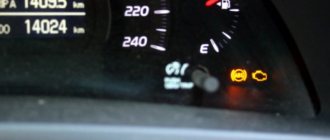Idle speed is an engine operating mode in which the gearbox is isolated from it. In this case, the throttle valve is in the closed position. This mode is designed to warm up the engine to the operating temperature of all ICE (internal combustion engine) systems. When the gas pedal is released, engine speed is maintained by the idle air control (IAC). It is this device on the Lada Kalina that ensures the supply of a minimum amount of air-fuel mixture to the cylinders.
Where is the IAC located and how does it work?
The Kalina idle speed sensor performs four main functions:
- Maintaining a certain number of engine revolutions.
- Providing conditions for starting the engine in winter at sub-zero temperatures. This means that the IAC can increase the speed so that the engine warms up faster. As operating temperature is reached, the speed gradually decreases.
- Maintaining minimum engine speed when the gas pedal is released. Many motorists underestimate this function until problems with starting and unstable engine operation begin.
- Creation of a fuel-air mixture with the required percentage of fuel and air. This ensures optimal fuel consumption and stable operation of the power plant.
Since the IAC is responsible for supplying air to the cylinders, it is located on the throttle assembly. The regulator on almost all naturally aspirated gasoline engines is located next to the throttle position sensor, and Kalina is no exception.
Reasons for the “signal light” to light up
Number 2 indicates that the warning light is on when the engine is running.
The main power unit warning light indicates that one of the systems has failed. Thus, it is worth paying attention, first of all, to the engine, where problems can be found. So, let's look at the main components where malfunctions can occur when the warning light is on:
General view of the fuel system
General view of the engine cooling system
Cracked spark plug
Battery installed on a car
List of ECU error codes
All these reasons can be associated with the warning light working when the engine is running on Kalina.
Elimination methods
So, as everyone knows, the engine warning light comes on when the ignition key is turned to the first position for a short period of time, and then goes off.
But, if the indicator lights up while driving, you need to pay special attention, because if it does not go out, you will have to look deeper for the problem.
So, it’s worth considering this issue in more detail, since not all car enthusiasts understand where exactly to look for a fault:
- Fuel system .
There are two options for solving the problem here. The first is to find a fault in the gasoline pump, which is immersed in the tank (tank capacity is 50 liters) and is located under the rear sofa. Maybe the contacts have come loose, but the entire system is worth checking completely. The second is the poor quality of gasoline, which results in a poor fuel mixture. What kind of gasoline do you fill up: 92 or 95?
- If the warning light comes on, it may indicate that the cooling system sensor has failed and the ECU thinks that the car is constantly hot or cold when driving.
- Clogged spark plugs can also cause the car to signal. A mixture that is too rich or too lean causes the engine to malfunction, thereby sending a command to the on-board PC about problems.
- A battery , or rather an insufficient charge, can cause the warning light to come on while driving.
- One of the most common malfunctions is ECU errors , which occur due to many factors. In this case, it’s worth cleaning everything and seeing if the warning light comes on again when driving.
- If clearing the error history of the electronic control unit did not help, then it is worth checking the main sensors located in the engine, and starting with the oxygen sensor.
The practical side of the issue
Type of indicator that lights up on the instrument panel
If you look from the practical side, many motorists note that there are certain factors that influence the fact that the engine system warning light comes on.
Operating principle of IAC
When the engine is running without increasing speed, that is, at idle, a minimum volume of air enters the combustion chambers of the cylinders. This occurs regardless of the throttle valve being in the closed position. The volume of intake air consumed is monitored and measured by the MAF (mass air flow sensor), which sends data to the ECU.
Based on the information received, the control unit supplies the required amount of fuel to the cylinders through the injectors. At the same time, the controller monitors the crankshaft speed using its position sensor (DPKV). According to the data obtained, the IAC needle opens or closes, controlling the air supply past the throttle valve, which at this stage is not involved in the operation of the engine.
If the engine has not yet reached the set temperature, the controller uses the IAC to increase the air supply, increasing the crankshaft speed to warm up the power unit faster. Thanks to this mode, the car can start moving almost immediately, without the need to reach operating temperatures.
Technically, the IAC is not a sensor, it is an actuator, so the controller cannot diagnose its malfunction. This means that the “Check Engine” icon will not light up on the instrument panel if the regulator breaks down. In their symptoms, IAC malfunctions are similar to TPS (throttle position sensor) malfunctions. But in the case of the latter, the icon will definitely light up, indicating engine problems.
Technical features of Kalina engines
Kalina owners sometimes complain that the engine is not working, and other problems appear, the causes of which you should know in order to be able to fix the breakdown yourself. The drive belt is most often damaged and is one of the main causes of engine failure. Filters and fuel lines become clogged. There are defects in regulators, piston rings, and rod valves. Another problem is low oil pressure. Let's look at each engine in more detail.
1.4 liter engine - in-line, 4-cylinder, injection. Made of cast iron, accepts AI-95 gasoline. This is a modified version of the power unit installed on the VAZ 21083. The same engine, only in a more powerful version, is installed on the Priora. Disadvantages include noise during operation, inefficiency and the fact that the unit bends the valves. The most common engine malfunctions relate to defects in the pump and rollers; belt jamming also occurs. To prevent breakdown, the timing belt, pump and rollers should be changed every 65,000 km.
If you want to improve the engine, you should know that this type of power unit is not the best option for tuning work. All that can be done is to install a Prior block. But it is strictly forbidden to install sport-type overhead camshafts, since in this case you will simply finish off the system without getting anything in return.
Kalina engine
The 1.6 liter engine has 2 incarnations. The first option is an 8-valve, installed on the standard version. There is a significant improvement in performance due to the reduction in the weight of spare parts. In addition, the parts have increased strength, which is achieved through heat treatment. And that is not all. The engineers worked hard to make the engine more powerful and stronger. For this purpose, they equipped it with an electric drive on the throttle valve. This technical solution brought 10% additional power. The advantages include engine efficiency and a low percentage of toxic emissions into the atmosphere.
The 16-valve engine is installed on luxury versions. It is equipped with a durable drive belt. In-line, 4-cylinder. This is an improved version of the power unit installed on the “ten”. But unlike that model, this unit has lightweight, higher quality, and more durable parts. The motor block has received a modern design that fully meets all the most stringent requirements of the present time.
Engine faults are in the timing belt, cylinders and pistons. The most common problems are related to defective pistons and gaskets due to overheating. As a result, there is a sharp decrease in power and engine failure. To solve these problems, it is necessary to replace the pistons with non-stick ones, and regularly check the engine to identify defective parts.
This is a good unit, but after a certain time it starts to knock, it rattles, it overheats, so it needs to be inspected regularly. When a knocking sound appears in the engine, it means that the hydraulic compensators have begun to fail. Either the piston or the bearings are knocking, which is a rather serious problem. Inattention and careless attitude to these issues can lead to a disastrous situation.
To increase engine power, you can install OKB "Dynamics 108" instead of the camshaft, and also adjust the phases and install a split gear. This manipulation will increase power. And if you modernize the intake manifold and cylinder head, the power will increase to 115 hp. With. But this is not the limit. Let's install a piston from Priora, and now we have all 120 hp. With.
An ambulance for the engine can be rebuilding the spark plugs, cleaning the injectors and the throttle valve. But the engine is a complex device. To competently approach its repair, you need to be patient and arm yourself with the most complete information about the upcoming work.
Signs of IAC malfunction
Among the signs that directly or indirectly indicate incorrect operation of the idle speed sensor are the following:
- the engine does not start well - it becomes impossible to start the engine without pressing the gas pedal;
- when switching to neutral gear, “dips” in speed and their instability are observed;
- when changing gears, the speed drops or the engine stalls completely;
- the engine does not warm up well at low temperatures, since increased speeds (1500 rpm) are not reached;
- after turning on energy consumers (high beams, heater, air conditioner), the speed begins to “sag” or “float”;
- The engine spontaneously increases and decreases speed.
The IAC cannot be repaired; the device must be replaced. Before changing the idle air regulator, it is advisable to flush the throttle assembly.
How to check the regulator
There are a lot of ways to diagnose ICC. The most effective and simple methods for checking the Kalina idle speed control:
- Routine IAC testing for performance. To do this, the device must be removed from the throttle assembly and the terminal block connected if it was disconnected for dismantling. After this you need to start the engine. At the moment of startup, the needle of a working device should extend. If this is not observed, the regulator is broken.
- Checking the supply of the required voltage to the sensor. You need to disconnect the terminal block from the IAC and connect a voltmeter to the terminals. After this, one person turns on the ignition, and the second measures the resistance at all terminals of the block. If there are no faults, the voltmeter reading should be approximately 50 ohms. The voltage should be at 12 V. If it is significantly less, this indicates a battery malfunction or an electrical circuit break in one of the sections.
- Measuring the resistance of the internal and external windings of the regulator. To do this you need to use a multimeter. The measurement results should not be lower than 40 Ohms and higher than 80 Ohms. If you deviate from the specified range, the idle air control must be changed.
Knowing the signs of problems, you can promptly diagnose IAC malfunctions and take measures to eliminate them. Although the regulator cannot be repaired, it is worth trying to clean it. In some cases this is enough.
Viburnum engine management system malfunction lamp
The ECM is capable of independently performing self-diagnosis to a certain extent. When a malfunction is detected, the ECM stores a fault code and may illuminate the malfunction indicator in the instrument cluster. The illumination of the malfunction indicator means that it is necessary to carry out diagnostics of the engine and ECM as soon as possible. It should be remembered that behind the electronics there is an internal combustion engine and the performance of the engine control system depends on the health of the mechanical systems. Below are a number of deviations that cause malfunctions that can be erroneously attributed to the electronic part of the engine management system: – insufficient compression; – air leak; – restriction of patency of the intake/exhaust system; – deviations of valve timing; – malfunctions caused by wear of parts, improper assembly and failure to comply with maintenance schedules; – poor fuel quality.
SECURITY MEASURES
When working on a vehicle with ECM repair, the following requirements must be observed:
- Before dismantling the controller, it is necessary to disconnect the ground wire from the battery.
- Do not start the engine without a secure connection to the battery.
- It is not allowed to disconnect the battery from the on-board network while the engine is running.
- When charging, the battery must be disconnected from the on-board network.
- It is necessary to monitor the reliability of the contacts of the wiring harnesses and maintain the cleanliness of the battery terminals.
- The design of the wiring harness blocks allows them to be connected to the mating part only in a certain orientation. If the orientation is correct, the connection of the harness block with the mating part is made without force. A connection with the wrong socket orientation may result in failure of the socket, module, or other system element.
- Connecting or disconnecting the ECM element pads while the ignition is on is not allowed.
- Before carrying out electric welding work, it is necessary to disconnect the wires from the battery and the connector from the controller.
- To prevent corrosion of the contacts, when washing the engine with a jet of water under pressure, do not point the sprayer at the system components.
- Voltage measurements should be made using a digital voltmeter with a rated internal resistance greater than 10 megohms.
- If the probe is to be used with a test lamp, it is necessary to use a lamp with a current consumption of no more than 0.25 A (250 mA).
- To prevent electrostatic discharge damage to electronic components, do not disassemble the metal housing of the controller or touch the connector plugs.
On-board diagnostics.
“On-board diagnostics” means a system of software and hardware (controller, sensors, actuators) that performs the following tasks: 1) Determination and identification of errors in the operation of the ECM and engine, which can lead to: – exceeding the limit values for vehicle exhaust gas toxicity , which are determined by the environmental standards currently in force in the relevant country for passenger cars; – to a decrease in engine power and torque, an increase in fuel consumption, and a deterioration in the driving characteristics of the vehicle; – to failure of the engine and its components (piston burnout due to detonation or damage to the catalytic converter in the event of misfires); – to emergency-dangerous behavior of the car. Electronic throttle control systems do not have a mechanical connection between the accelerator pedal and the throttle valve. In this regard, increased requirements are placed on on-board diagnostics to ensure safe vehicle behavior when various malfunctions occur. 2) Informing the driver about the presence of a malfunction by turning on the malfunction indicator. 3)Saving information about the fault. At the moment of detection, the following information is entered into the controller’s memory: – fault code according to the international classification (see Table 1) ; – status flags (signs) characterizing the malfunction at the time of the information exchange session with the diagnostic device; – the so-called freeze frame – the values of parameters important for the ECM at the time the error was registered. 4) Activation of emergency operation modes of the ECM. If a malfunction is detected, the system switches to emergency operating modes, providing the ability to safely drive to a service station. The behavior of the vehicle in emergency mode depends on the specific malfunction detected. For example, in the event of a malfunction of the coolant temperature sensor, replacement engine temperature values calculated from indirect parameters are used to control the engine, and the cooling system fan is also turned on. If any malfunction of the throttle assembly (mechanical or electrical) is detected, the controller de-energizes the electric throttle drive and also limits the maximum engine speed. 5) Ensuring interaction with diagnostic equipment. The presence of a malfunction is indicated by the on-board diagnostic system by turning on the warning light. The on-board diagnostic system must then use special equipment to obtain diagnostic information stored in the controller's memory. For this purpose, a serial information transmission channel is organized in the engine control system, which includes an ECM controller, a standardized block for connecting a diagnostic tool and a wire connecting them (K-line). In addition to the block, the information transfer protocol and the format of transmitted messages are also standardized. In addition to obtaining information about detected malfunctions and the state of the engine control system, the on-board diagnostic system allows you to perform a number of verification tests by controlling the actuators. The main component of the on-board diagnostic system is the ECM. In addition to its main task (controlling the combustion processes of the fuel mixture), it performs self-diagnosis. When performing this function, the controller monitors signals from various sensors and actuators of the ECM. These signals are compared with reference values stored in the controller's memory. And if any signal goes outside the control values, the controller evaluates this condition as a malfunction (for example, the voltage at the sensor output has become zero - short circuit to ground), generates and writes the corresponding diagnostic information to the error memory (see below) , turns on the warning lamp (alarm) indicating malfunctions, and also switches to emergency operating modes of the ECM. The on-board diagnostic system begins to function from the moment the ignition is turned on and stops after the controller switches to the “stand by” mode (occurs after the main relay is turned off). The moment of activation of one or another diagnostic algorithm and its operation are determined by the corresponding engine operating modes. Diagnostic algorithms can be divided into three groups: 1) Sensor diagnostics. The controller, by monitoring the value of the sensor output signal, determines the presence or absence of a malfunction. 2) Diagnostics of ECM actuators (driver diagnostics). The controller checks the control circuits for opens, shorts to ground, or shorts to the power source. 3) Diagnostics of ECM subsystems (functional diagnostics). There are several subsystems in the engine control system:
- Ignition.
- Fuel supply.
- Maintain idle speed.
- Capturing gasoline vapors, etc.
Operating principle of the throttle valve
This device reduces or, conversely, increases the air supply to the engine cylinders, enriching or leaning the mixture with fuel.
When the driver presses the gas pedal, the throttle valve opens, allowing more air into the combustion chambers. Oxygen is mixed with fuel, after which the prepared mixture burns. The more the driver presses the gas pedal, the wider the throttle opens and the more air flows in. But often carbon deposits accumulate on the walls of the damper, and its loose closure causes disturbances in the operation of the power plant.
The throttle assembly is located behind the engine air filter. This arrangement is typical not only for the Lada Kalina, but also for many other cars. Depending on the engine type, the damper operation can be controlled by an electronic gas pedal or a cable drive.
Removing the throttle
Before cleaning this device, it must be removed. You can wash it without removing it, but this method is less reliable and effective. The dismantling process is as follows:
- Disconnect the air pipe that goes from the air filter directly to the throttle body.
- Remove the throttle cable drive.
- Disconnect the throttle body heating hoses that supply coolant - it is best to carry out the work on a cool engine. To avoid draining antifreeze, these hoses can be plugged.
- Disconnect the terminal blocks from the throttle position sensor and IAC.
- Unscrew the 4 fastening nuts and remove the throttle assembly assembly.
This completes the dismantling. The work is not difficult, even a beginner can do it.
Cleaning the damper
Using cleaning products, you can wash the damper at home. Additionally, you will need several pieces of clean rags. Algorithm for the cleansing process:
- After dismantling the throttle assembly, you need to remove the idle speed control and TPS, as well as all accessible rubber seals, since the cleaning agent is quite aggressive and can corrode them.
- Typically, cleaning fluid comes in an aerosol can. The jet must be directed to the damper, all air channels and internal walls. External cleaning is not necessary.
- After treatment, you need to wait 10-15 minutes for the product to eat away carbon deposits and dirt.
- Next, wipe the surfaces with a rag; if the surface is heavily soiled, the treatment can be repeated.
Never use metal brushes or other abrasive materials to clean the throttle body. The internal surface of the unit is coated with molybdenum, damage to which can lead to metal oxidation and corrosion.
Lada Kalina engine troubles: check light is on, reasons
Author: premierautos · Published 07/06/2010 · Updated 07/29/2018
- Circumstances
- Remedies
- Low quality fuel
- Fuel cells
- Spark generator
- Air supply
- Motor mechanics
- Electronics
- Conclusion
A fire on the “Check Engine” indicator device panel indicates that not everything is fine with the engine, or rather, some structural element has failed or is malfunctioning.If the engine of a Lada Kalina is misfiring and the check light is on, this indicates that one of the elements is disrupting the entire operation of the engine. In order to find the reasons, the car enthusiast must have some constructive knowledge, and in addition to this, the structure and operating principle of an injection-type internal combustion engine.
If the Kalina engine fails, then the reason should be looked for in the formation of an air-fuel mixture, or there may be no spark in one of the cylinders. In addition, the circumstance that caused the tripping may be faulty electronics. So, let’s look at which nodes you need to look for circumstances:
- Low quality fuel.
- Spark generator: spark plugs or high-voltage wires.
- Air supply: throttle and filter.
- Engine mechanics: valves, pistons and others.
- Electronics: control unit and sensors.
Fuel elements: pump, filter, injectors.
In order to eliminate the tripping effect on a vehicle, you need to stock up on time, because it may take the whole day, and in addition, tools. To work, you will need a set of keys, screwdrivers and a head, and in addition a multimeter.
So, let's look at how to fix the problems that have arisen.
Many skilled Kalinovods on the forums describe what is causing problems with the Kalina engine as the use of low-quality fuel. As a result, the “Check Engine” warning light on the dashboard may light up.
The on-board computer will detect a poor-quality mixture based on the combustion process. But this is not the worst thing. Poor quality gasoline can clog elements throughout the entire system.
The result of prolonged use of this type of fluid can lead to the valve mechanism burning out, and also the pistons. In this case, overhaul becomes inevitable, because the parts wear out at an accelerated rate.
If it is discovered that the gasoline is of poor quality, the motorist will face a whole range of repair operations, namely:
- Cleaning the fuel tank and replacing the filter.
- Cleaning or changing spark plugs.
- checking and dismantling injectors.
- And finally, disassembling the cylinder head.
After cleaning, you need to fill in high-quality gasoline and drive it. The CHECK icon must turn itself off when high-quality fuel enters the system.
A clogged filter and fuel pump may be the cause of the leakage result. So, the fuel pump has a filter mesh that could become clogged. To eliminate the malfunction, you need to pull out the pump and examine its condition.
As for the fuel filter element, it is recommended to replace it because, most likely, it is clogged.
Spark plugs and high-voltage wires play a role in spark formation, which also tend to wear out. So, a car enthusiast needs to unscrew the spark plugs and examine them for cracks.
After this, it is worth checking them for presence and contact resistance. This is done on a special spark plug stand, but it can also be done manually without leaving the car.
Owners of old Volgas and Ladas are very familiar with the second method.
High-voltage wires are checked quite easily. Using a multimeter, an indicator such as resistance is measured.
For each wire it should be close to 5 ohms.
The third part, which is responsible for the formation and normal combustion process of the air-fuel mixture, is the air supply. The main elements of the assembly can be considered the air filter and the throttle valve.
The condition of the air filter element plays a huge role in how the fuel burns. Based on this, when searching for the circumstances of tripping, you need to study the condition of the part and assembly.
If the air filter is extremely clogged or has oil residues, then this is the reason for the engine to trip, because the usual air-fuel mixture is not formed.
The second element of the assembly, the contamination of which leads to the motor tripping, is the throttle. In order to eliminate the malfunction, you need to dismantle the unit from the vehicle and clean it.
In most cases, this is done using special products or carburetor cleaning fluid. Along with this unit, it is recommended to clean the corrugation supplying the air space.
The worst dream of any car enthusiast is damage to the engine mechanics. In most cases, this leads to a major overhaul of the power unit.
In this case, the tripping could be caused by the burnout of the formation and valves of the gap between the seat and the valve.
To eliminate the malfunction, you need to dismantle the block head and inspect the condition of each valve. If there are burnt elements, you need to prepare for the worst - repairing the cylinder head.
In addition, it is recommended to inspect the condition of the parts and assemblies of the cylinder block; perhaps they are also worn out and require the intervention of a car enthusiast.
The “Check Engine” warning light may come on due to faulty electronics, or due to the failure of the sensors. This may result in a tripling effect.
In order to eliminate the malfunction, you need to perform diagnostic operations, and just diagnose the sequence of sensors. Malfunction of which meters can lead to motor tripping:
- Coolant temperature sensor.
- Mass air flow sensor.
- Idle speed regulator.
- Knock sensor.
- Throttle position sensor.
- Crankshaft position sensor.
Diagnosis of meters is carried out using a multimeter. To do this, you should disconnect the wire block and ring each pair of contacts.
The last place that can lead to this is the electronic engine control unit. Many mechanics and mechanics are confident that this unit is worth getting into first. But every connection to the ECU has consequences for its operation.
One awkward move and it is possible to disrupt functions that can lead to tragedy. But, in the second way, you can’t calculate the inaccuracies, which leads to a paradox.
Having connected to the control unit, you need to use special software to find out where the fault lies and fix it either at the software level or in the mechanics.
The circumstances that could cause the Check Lada Kalina warning light to come on, and besides this, the origin of the engine tripping, are quite easy. You just need to know the design of the power unit, and besides this, the operating principle of its components and systems.
It is not always possible to fix malfunctions on your own; therefore, in case of failure, it is recommended to contact a car service center.
Replacing the idle air control
To do the job you only need a shaped screwdriver. If dismantling involves removing the entire throttle assembly, you need to prepare a set of standard socket wrenches or sockets.
- First, wait until the engine has cooled down, after which you can disconnect the terminals from the battery.
- The clamps must be removed from all hoses.
- From the idle speed control and throttle position sensor, disconnect the wire chips and remove the throttle cable.
- The throttle heating hoses must be removed and plugged.
- Use a 13mm wrench to unscrew the fastening nuts, then the throttle assembly can be removed.
- Next, all that remains is to unscrew the two screws holding the idle speed control and remove it. A new IAC is installed in its place and secured with two screws.
You should not touch, much less move, the sensor rod - such manipulations can lead to failure of the device. If, after starting, increased engine speeds are observed (more than 1500 rpm), then there is nothing to worry about. If such a situation occurs, you need to turn off the engine and start it again - the position of the IAC valve will be calibrated and the speed will return to normal.
The throttle assembly is installed in the reverse order of removal. If cleaning of the damper is not required, the sensor can be replaced without dismantling the unit. When tightening all nuts, be careful not to loosen the fasteners. Otherwise, the sensor will vibrate when the engine is running and will quickly become unusable.
During operation of the car, you need to periodically check all its systems and mechanisms, diagnosing possible malfunctions in the early stages. IAC Lada Kalina should also be tested occasionally. The needle and, in general, the entire throttle assembly should not be allowed to become heavily contaminated.
At the slightest disturbance in the stability of the engine, it is necessary to carry out a thorough check and eliminate all possible malfunctions. Only in this case will the car work reliably and for a long time.
I dug up information on IAC. The signs are exactly like mine!
The idle speed regulator is a device that is necessary in the system to stabilize the idle speed of the engine.
While the engine is idling, by changing the flow area of the additional air supply channel, bypassing the closed throttle valve, the amount of air necessary for its stable operation enters the engine. This air is taken into account by the mass air flow sensor (MAF) and, in accordance with its quantity, the controller supplies fuel to the engine through the fuel injectors.
Using the crankshaft position sensor (CPS), the controller monitors the number of engine revolutions and, in accordance with the engine operating mode, controls the idle speed regulator, thus adding or reducing the air supply bypassing the closed throttle valve.
When the engine is warmed up to operating temperature, the controller maintains idle speed. If the engine is not warmed up, the controller increases the speed using the idle speed regulator and, thus, ensures warming up of the engine at increased crankshaft speeds.
Checking the technical condition of the engine
The technical condition of the engine depends on the mileage of the vehicle, the timeliness of periodic maintenance, the quality of the operating materials used, as well as the quality of repairs.
The condition of the engine should be monitored regularly during vehicle operation. Signs of malfunctions may include: the presence of oil drops where the car is parked; the engine malfunction indicator light or the emergency oil pressure indicator light comes on, the appearance of an extraneous sound (noise, knocking) when the engine is running: smoky exhaust; movement of the temperature gauge needle to the red zone; increased oil consumption, noticeable loss of power. If at least one of the listed signs is detected, it is necessary to conduct a more detailed check. Checks of the technical condition of engine systems are shown in the relevant sections of the chapter “Engine and its systems”.
The technical condition of the engine can be assessed with sufficient accuracy by external signs and using available equipment (compressometer, pressure gauge, technical stethoscope).
Execution Sequence
1. We prepare the car for work
2. We inspect the engine from above and on an inspection ditch or overpass from below. Oil leaks may indicate wear of the oil seals or gaskets.
3. We start the engine, and the emergency oil pressure indicator lamp should go out. If the warning light comes on at idle after warming up the engine and goes out after increasing the crankshaft speed, then the oil pump gears, crankshaft journals, main and connecting rod bearings may be worn out. If the lamp is constantly on, then the lubrication system or emergency oil pressure sensor may be faulty. We check the oil pressure in the engine lubrication system using a pressure gauge.
Operating a vehicle with insufficient oil pressure in the lubrication system will result in serious engine damage.
4. After warming up the engine, listen to its operation.
It is convenient to diagnose engine malfunctions by ear using a technical stethoscope. With its help, you can quite accurately determine the source of extraneous noise.
Attention! To avoid injury, when performing the following operation, do not touch moving engine parts (pulleys, belt) or touch hot engine parts.
5. When an extraneous sound appears, use a stethoscope to determine the area where this sound is most audible. Based on the nature of the sound and the location of the sound emission, we determine the possible source of the sound and the possible malfunction.
A ringing clicking sound under the cylinder head cover, as a rule, indicates a malfunction of the hydraulic compensators in the valve drive; uniform noise in the timing belt area may indicate wear on the bearings of the tension and guide rollers or the bearing of the coolant pump. Knocks at the bottom of the cylinder block and on the side of the oil pan, which intensify with increasing crankshaft speed, are caused by a malfunction of the main bearings. In this case, as a rule, the oil pressure in the lubrication system is low. At idle, this sound is low in tone, and as the speed increases, its tone increases. When you press the gas pedal sharply, the engine emits something similar to a growl - like “gur-r-r”. Loud knocking noises in the middle part of the cylinder block are caused by faulty connecting rod bearings. A rhythmic metallic knock at the top of the cylinder block, heard in all engine operating modes and increasing under load, is caused by a malfunction of the piston pins. A muffled knocking sound at the top of the cylinder block on a cold engine, which subsides and disappears when warmed up, can be caused by worn pistons and cylinders. Operating a vehicle with faulty bearings and pins will lead to engine failure.
6. If oil consumption increases and no signs of leakage are found:
a) warm up the engine to operating temperature.
b) disconnect the crankcase ventilation hose from the throttle valve.
c) bring a sheet of paper to the hose. If oil stains appear on the paper, then the cylinder-piston group is worn out. The degree of wear is determined by compression in the cylinders.
d) if oil mist does not come from the ventilation system, then the cause of increased oil consumption may be wear of the valve stem seals. In this case, the car will have a smoky exhaust.
Operating an engine with a worn cylinder-piston group, faulty valve stem seals, or low-quality fuel leads to failure of the catalytic converter and oxygen concentration sensor.
Simple tips for prevention
To ensure that a small sensor does not cause you much trouble, and its service life increases, you must follow several basic rules:
- Make sure that no liquid gets into the throttle valve area, so that moisture and dirt do not accumulate there.
- Since the IAC is a “controller” of air intake, you must remember to change all air filters on time.
- Leaving a car outside in winter is strictly prohibited, everyone knows this, but not everyone has the opportunity to find a covered, heated room for their car. Therefore, if your car spends the winter outside and is hardly driven, then at least start it from time to time, warm up the engine, and change the gas. For what? So that the idle speed controller “comes to life” is being developed. Otherwise in the spring, at the first attempt to start, it will jam.
It is very important to keep the interior and appearance of the car in order. But it is even more important to monitor the serviceability of its internal parts, and especially the engine. After all, it is to a machine as a heart is to a person. There are no unimportant details in it. Every detail of the “heart of iron” contributes to its optimal performance. One of them is the idle speed regulator, which is not so difficult to put in order.
Where is the idle speed sensor on the Lada Kalina and its replacement
Car: Lada Kalina. Asks: Ivan Vinokurov. The essence of the question: I want to replace the idle speed sensor, but I don’t know where it is located?
Good afternoon, I recently had this problem. When I stop at a traffic light, the idle speed starts to fluctuate, up and down! Friends say that the reason may be in the idle speed sensor, but I don’t know where it is located. Please tell me how to find it and how to solve my problem?
The idle speed sensor or, in other words, the idle speed controller (IAC) is designed for stable engine operation when the gas pedal is released. It is this device that provides a minimum supply of air and fuel when the car is stationary and idling.
The following two tabs change content below.
Expert on Renault cars I own a Renault Megane 2, before that there were Citroens and Peugeots. I work in the service area of a dealership, so I know the car inside and out. You can always contact me for advice.
Replacing the idle speed sensor (video)
Dismantling the IAC
- First of all, before starting the replacement, turn off the engine and open the hood.
- The regulator itself is located on the throttle body, slightly lower than the damper position sensor.
- This photo shows how to find it visually by simply looking a little further under the hood.
The idle speed control is marked with a red marker.
- Next, remove the wire block by first unhooking the latch from its body.
- And then unscrew the two bolts using a regular Phillips screwdriver. (Please note that you should choose a screwdriver with a short blade, otherwise it may simply not fit in a limited space).
- When the bolts are unscrewed, we simply pull the regulator body towards us, and it calmly gives in.
- Now that the device has been dismantled, you can easily determine and decide whether to replace the sensor with a new one or start cleaning it.
- If there is carbon deposits on the regulator, but there is no mechanical damage, no parts are falling off its body, and its condition inspires confidence in you, then you can easily simply clean it.
- For this we only need carburetor cleaner and a clean rag. Using it, fill all the holes and niches, clean everything with a rag and let it dry for a certain time.
We put the unscrewed screws in a safe place.
IAC inspection
This is what a “dirty” IAC may look like.
And so after cleaning.
